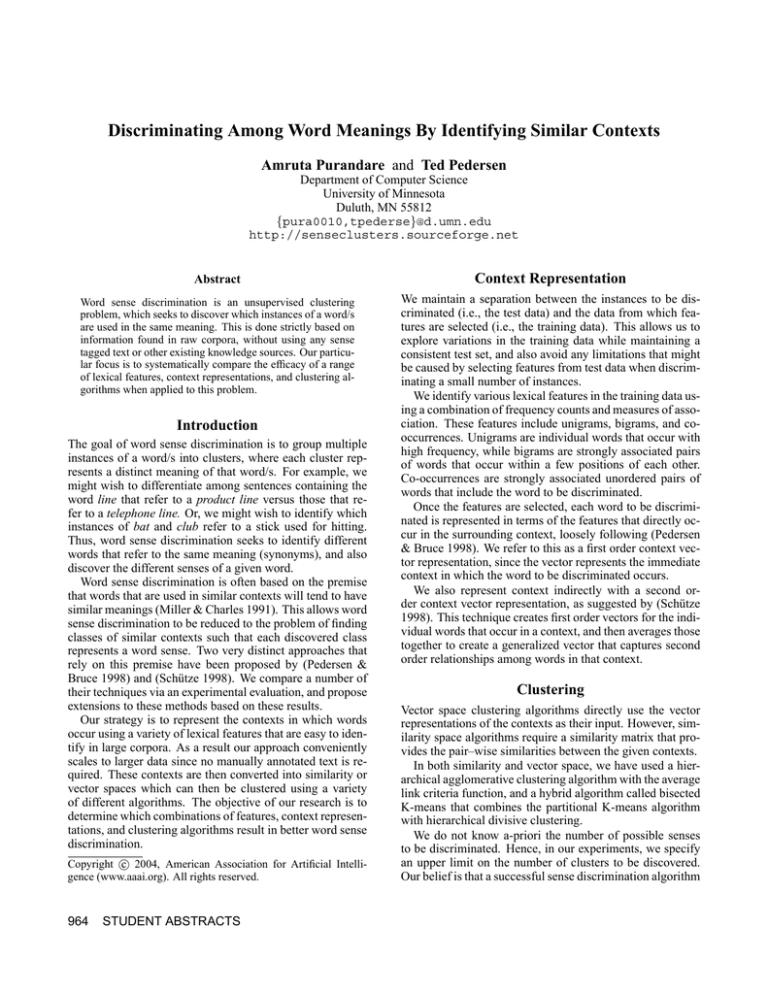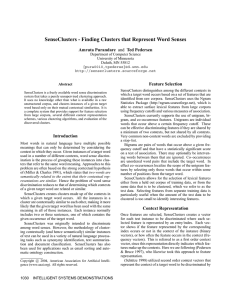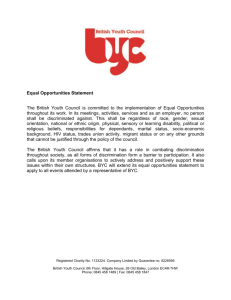
Discriminating Among Word Meanings By Identifying Similar Contexts
Amruta Purandare and Ted Pedersen
Department of Computer Science
University of Minnesota
Duluth, MN 55812
{pura0010,tpederse}@d.umn.edu
http://senseclusters.sourceforge.net
Abstract
Context Representation
Word sense discrimination is an unsupervised clustering
problem, which seeks to discover which instances of a word/s
are used in the same meaning. This is done strictly based on
information found in raw corpora, without using any sense
tagged text or other existing knowledge sources. Our particular focus is to systematically compare the efficacy of a range
of lexical features, context representations, and clustering algorithms when applied to this problem.
We maintain a separation between the instances to be discriminated (i.e., the test data) and the data from which features are selected (i.e., the training data). This allows us to
explore variations in the training data while maintaining a
consistent test set, and also avoid any limitations that might
be caused by selecting features from test data when discriminating a small number of instances.
We identify various lexical features in the training data using a combination of frequency counts and measures of association. These features include unigrams, bigrams, and cooccurrences. Unigrams are individual words that occur with
high frequency, while bigrams are strongly associated pairs
of words that occur within a few positions of each other.
Co-occurrences are strongly associated unordered pairs of
words that include the word to be discriminated.
Once the features are selected, each word to be discriminated is represented in terms of the features that directly occur in the surrounding context, loosely following (Pedersen
& Bruce 1998). We refer to this as a first order context vector representation, since the vector represents the immediate
context in which the word to be discriminated occurs.
We also represent context indirectly with a second order context vector representation, as suggested by (Schütze
1998). This technique creates first order vectors for the individual words that occur in a context, and then averages those
together to create a generalized vector that captures second
order relationships among words in that context.
Introduction
The goal of word sense discrimination is to group multiple
instances of a word/s into clusters, where each cluster represents a distinct meaning of that word/s. For example, we
might wish to differentiate among sentences containing the
word line that refer to a product line versus those that refer to a telephone line. Or, we might wish to identify which
instances of bat and club refer to a stick used for hitting.
Thus, word sense discrimination seeks to identify different
words that refer to the same meaning (synonyms), and also
discover the different senses of a given word.
Word sense discrimination is often based on the premise
that words that are used in similar contexts will tend to have
similar meanings (Miller & Charles 1991). This allows word
sense discrimination to be reduced to the problem of finding
classes of similar contexts such that each discovered class
represents a word sense. Two very distinct approaches that
rely on this premise have been proposed by (Pedersen &
Bruce 1998) and (Schütze 1998). We compare a number of
their techniques via an experimental evaluation, and propose
extensions to these methods based on these results.
Our strategy is to represent the contexts in which words
occur using a variety of lexical features that are easy to identify in large corpora. As a result our approach conveniently
scales to larger data since no manually annotated text is required. These contexts are then converted into similarity or
vector spaces which can then be clustered using a variety
of different algorithms. The objective of our research is to
determine which combinations of features, context representations, and clustering algorithms result in better word sense
discrimination.
c 2004, American Association for Artificial IntelliCopyright gence (www.aaai.org). All rights reserved.
964
STUDENT ABSTRACTS
Clustering
Vector space clustering algorithms directly use the vector
representations of the contexts as their input. However, similarity space algorithms require a similarity matrix that provides the pair–wise similarities between the given contexts.
In both similarity and vector space, we have used a hierarchical agglomerative clustering algorithm with the average
link criteria function, and a hybrid algorithm called bisected
K-means that combines the partitional K-means algorithm
with hierarchical divisive clustering.
We do not know a-priori the number of possible senses
to be discriminated. Hence, in our experiments, we specify
an upper limit on the number of clusters to be discovered.
Our belief is that a successful sense discrimination algorithm
will automatically discover approximately the same number
of clusters as actual senses for a word, and that the excess
clusters will contain very few instances and can be safely
discarded without fear of affecting overall performance.
Experimental Results
We have carried out experiments using the line, hard, and
serve sense–tagged corpora, each of which has approximately 4,000 instances. We have also used a subset of the
words from the sense–tagged S ENSEVAL -2 corpus. These
represent much smaller quantities of data, since there are
50–200 sense tagged instances for each word. We evaluate
our results in terms of precision and recall, which measure
the degree to which the discovered clusters correspond with
the true word senses as indicated by the sense–tags.
Experimental results described in (Purandare 2003) and
(Purandare & Pedersen 2004b) show that bigrams and cooccurrences with high degrees of association according to
the log–likelihood ratio prove to be particularly useful. We
have also found that the first order context representation
results in more accurate discrimination when discriminating
the larger line, hard and serve corpora. The second order
representation performs better when given smaller corpora
such as the S ENSEVAL -2 words.
We hypothesize that the sparseness of the features in
smaller corpora causes the first order methods to perform
poorly, while second order methods are able to better identify features when given limited data. However, both representations lead to very sparse representations regardless of
the corpora size. As such we are experimenting with Singular Value Decomposition (SVD) to reduce sparsity and convert the word level feature space into a conceptual semantic
space, as is done in Latent Semantic Analysis (Landauer,
Foltz, & Laham 1998).
Future Work
In our experiments to date, our training data has consisted
of instances of the word/s to be discriminated. Thus, the
training and test data are fairly homogeneous, and focus on
the particular word to be discriminated. We plan to conduct
experiments where the features are selected from a huge corpus that is not specific to the words being discriminated. We
will draw from a variety of sources, including the British National Corpus, the English GigaWord Corpus, and the Web.
Our motivation is that huge corpora will provide more
generic co–occurrence information about words without regard to a particular word to be discriminated. It is not clear if
this will be more effective than our current approach, which
captures co–occurrence behavior in the immediate context
of the word to be discriminated.
We are also developing a method to attach descriptive labels to the discovered clusters. These labels will define the
sense of the cluster, and will be based on the most characteristic features of the instances that belong to that cluster. We
will then map the discovered clusters to established dictionary senses by matching the automatically derived labels to
the existing definitions. This will allow us to associate our
clusters with an existing sense inventory, making it possible
to perform fully automatic word sense disambiguation that
does not rely on any manually annotated text.
Conclusions
We have conducted an extensive comparative analysis of
word sense discrimination techniques using first order and
second order context vectors, where both can be employed
in similarity and vector space. We conclude that for larger
amounts of homogeneous data such as the line, hard and
serve data, the first order context vector representation and
average link clustering algorithm as proposed by (Pedersen
& Bruce 1998) is most effective. We believe this is the case
because in a large sample of data, it is very likely that the
features that occur in the training data will also occur in the
test data, making it possible to represent test instances with
fairly rich feature sets.
When given smaller amounts of data like the S ENSEVAL 2 words, second order context vectors and a hybrid clustering method such as repeated K–means perform better. We
believe that this occurs because in small and sparse data,
direct first order features are seldom observed in both the
training and the test data. However, the indirect second order co–occurrence relationships that are captured by these
methods provide sufficient information for discrimination to
proceed.
Acknowledgments
This research is supported by a National Science Foundation
Faculty Early CAREER Development Award (#0092784).
All of the experiments described in this paper were conducted using version 0.47 of the SenseClusters package (Purandare & Pedersen 2004a), which is freely available from
SourceForge.
References
Landauer, T.; Foltz, P.; and Laham, D. 1998. An introduction to latent semantic analysis. Discourse Processes
25:259–284.
Miller, G., and Charles, W. 1991. Contextual correlates
of semantic similarity. Language and Cognitive Processes
6(1):1–28.
Pedersen, T., and Bruce, R. 1998. Knowledge lean word
sense disambiguation. In Proceedings of the Fifteenth National Conference on Artificial Intelligence, 800–805.
Purandare, A., and Pedersen, T. 2004a. Senseclusters finding clusters that represent word senses. In Proceedings
of the Nineteenth National Conference on Artificial Intelligence.
Purandare, A., and Pedersen, T. 2004b. Word sense discrimination by clustering contexts in vector and similarity
spaces. In Proceedings of the Conference on Computational Natural Language Learning.
Purandare, A. 2003. Discriminating among word senses
using mcquitty’s similarity analysis. In Proceedings of the
HLT-NAACL 2003 Student Research Workshop, 19–24.
Schütze, H. 1998. Automatic word sense discrimination.
Computational Linguistics 24(1):97–123.
STUDENT ABSTRACTS 965





